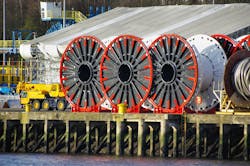Frontier is set on expanding its fiber-to-the-home (FTTH) network within and outside of its traditional service territory.
During its second-quarter earnings call, the service provider highlighted its recent fiber securitization transaction. This transaction, finalized on August 9, priced $2.1 billion of committed capital that Frontier will use to continue to fund its fiber expansion.
Frontier plans to pass at least 10 million locations with fiber. At the end of the second quarter, the telco said it was more than halfway there with over 6 million fiber locations.
“If macro climate and capital markets remain stable, we're confident in our plan to pass at least 1.3 million new fiber locations annually and complete our committed build to 10 million,” said Nick Jeffery, CEO of Frontier, during the second-quarter earnings call. “And while we see a clear path to 10 million fiber locations, our ambitions go far beyond that. We plan to be active participants in government programs like BEAD and to pursue additional opportunities, both in and out of our footprint.”
Enhancing penetration, ARPU
Frontier continued to see fiber broadband and ARPU growth in the second quarter as more customers migrated to higher-speed broadband tiers.
The telco added 66,000 new fiber customers, up 22% from the second quarter of 2022. Also, its broadband customer base grew 19% over the last 12 months. In its base fiber footprint of 3.2 million locations, penetration increased 80 basis points year-over-year to 43.4%.
However, the growth missed analysts’ expectations. “Although it dipped sequentially, due to seasonality in our footprint, we are ahead of where we expected to be at the end of the year's first half,” said Scott Beasley, CFO of Frontier. “And our first-half gains put us on track to achieve our target penetration rate of at least 45% in the next two to three years.”
Another critical factor was the adoption of higher speeds. “In the second quarter, more than half of all our new customers chose gig plus speeds,” Beasley said.
Jeffrey said that by making disciplined changes to its pricing and the way it packages offers, designed to bring ARPU more in line with our competitors in line with the market. This included reducing the use of gift cards, price-to-market adjustments, unbundling our value-added services and incentivizing customers to choose gig-plus speeds.
“In the second quarter, more than half of all our new customers chose gig plus speeds,” he said. “And simultaneously, new customer intake ARPU has now climbed into the $70 range.”
Eying fiber consolidation
While Frontier said it is committed to building fiber to 10 million fiber homes passed with high and attractive IRRs, the company is keenly aware of the growing presence of regional fiber overbuilders that it could acquire to complement its build-out plan.
Jeffery said that since fiber is a challenging asset to build, it needs to look at potential inorganic means “to go beyond 10 million fiber homes passed goal.”
He added that network consolidation is a standard process seen in other segments of the service provider industry. “It's also inevitable if we look at the evolution of the cellular market and how that consolidated in the past, the evolution of the cable market and how that consolidated in the past,” Jeffery said. “The very fragmented fiber market is also likely to consolidate. And as the largest pure-play fiber provider, we certainly see ourselves playing an important role in that consolidation. But I come back to the fact that our focus day in, day out operationally is to deliver the high IRRs and good returns from our committed 10 million fiber build.”
But when it comes to seeing competitive threats from emerging FTTH players, Jeffery is less concerned because they need more resources to build large networks. “In terms of new competitors, overbuilders, and so on, we see some, of course, but none at scale,” he said. “And it takes much work to start a new fiber build first. Given the complexities of labor and equipment and all of that, I'd like to know how we would do that if we were setting off right now.”
Frontier’s second-quarter revenue was $1.45 billion, which was up sequentially as growth in data and internet services offset declines in voice and video.
About the Author
Sean Buckley
Sean is responsible for establishing and executing the editorial strategy of Lightwave across its website, email newsletters, events, and other information products.

